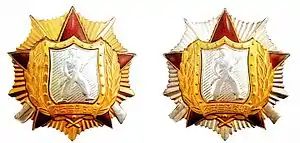Orders, decorations, and medals of North Korea
The award system of the Democratic People's Republic of Korea (North Korea) was initially created less than one month after the foundation of the Republic. During the years of Japanese Occupation of North Korea, many of the future leaders fled to the Soviet Union. During World War II many if not close to all party leaders and KPA commanders served in the Soviet Army and as such adopted many of the Soviet Awards criteria for their own. During the late 1940s and until the Sino-Soviet Split in late 1958, orders and titles were made in the Soviet Money Mints in Moscow or Leningrad. Soviet made awards were modeled after Soviet orders and made of sterling silver. Initially the Orders were attached to clothing with a screw-plate, but after Soviet production stopped, production was moved to North Korea. The screwback was replaced with a pin and the silver content was replaced with cheap tin. With the exception of a few examples of modern orders, Soviet and Czech KPA awards are the most sought after in current militaria markets.
Titles
(English/Korean/Transliteration) |
|||
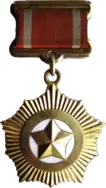 |
공화국영웅 Konghwaguk Yŏng'ung |
1950-06-30 | The "Hero of the Republic" was the highest award of the Democratic People's Republic Of Korea until the Order of Kim Il-Sung was established in 1972. Awarded for extreme heroic exploits during war. The recipient is also awarded with the Order of the National Flag 1st Class which was the nation's highest Order until the Order of Kim Il-Sung. Along with the Gold Star and Order the Recipient is also honoured with the erection of a personal statue at their birthplace. This award is based upon the Soviet award "Hero of the Soviet Union". |
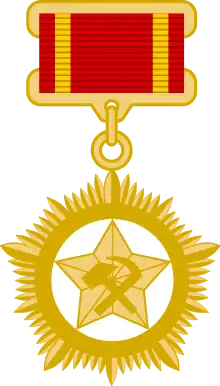 |
로력영웅 Roryŏk Yŏng'ung |
1951-07-17 | This title was the highest civilian award until the establishment of the Order of Kim Il-Sung in 1972. Awarded for exceptional merit and efficiency in professional labour. The recipient of this title was also awarded the Order of the National Flag 1st Class which was also the nation's highest order until the Order of Kim Il-Sung. This award is based upon the Soviet award "Hero of Socialist Labour". |
Orders
(English/Korean/Transliteration) |
|||
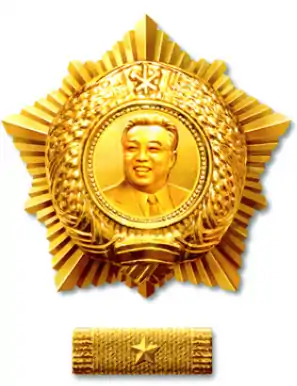 |
김일성 훈장 Kim Ilsŏng Hunjang |
1972-03-20 | The Order of Kim Il-sung is the highest decoration of the country. It is awarded for contributions to the revolution or upholding the dignity of the country at home or abroad. It is usually awarded around April 15 (Day of the Sun, the birthday of Kim Il-sung). Kim Jong-il was its first recipient, although he rejected the order first.[1] |
 |
김정일 훈장 Kim Chŏngil Hunjang |
2012-02-03 | With the issuance of Decree 2150 by the Presidium of the Supreme People's Assembly on 3 February 2012, the Order of Kim Jong-il was created for the 70th anniversary of his birth. The order measures 67mm in length and 65mm in width. It features the portrait of Kim Jong-il in the centre of golden ears of rice above a shining five-point star, the flag of the DPRK below and the emblem of the Workers' Party of Korea above with an engraving of "Order of Kim Jong-il" on the back with pin and serial number. It is made to give commendation to officials, service personnel, working people, military units, organs, enterprises, and organizations who provided distinguished service to the DPRK. The order ribbon is similar to the Order of Kim Il-sung in colour and the star at the centre, but its design is different. |

|
1st Class 국기훈장 제1급 Kukki Hunjang Che il-gŭp |
1948-10-02 | Until the creation of the Order of Kim Il-sung in 1972, the highest order of the Democratic People's Republic of Korea. The ONF was based on the awarding criteria of the Soviet Order of the Badge of Honour. Awards were present to those that exemplified themselves in the fields of Science, Economics, and teachings of Socialist Ideologies. |

|
2nd Class 국기훈장 제2급 Kukki Hunjang Che i-gŭp |
1948-10-02 | Order ribbon has 2 gold stripes indicating 2nd Class. |

|
3rd Class 국기훈장 제3급 Kukki Hunjang Che sam-gŭp |
1948-10-02 | Order ribbon has 3 small gold stripes indicating 3rd Class. |
조선로력훈장 Chosŏn Roryŏk Hunjang |
1951-07-17 | For efficient and meritorious professional labour.
Notable recipients:
| |
|
1st Class 전사영예훈장 제1급 Chŏnsa Yŏng'ye Hunjang Che il-gŭp |
1950-06-25 | For acts of individual gallantry in combat. The insignia design is similar to the Soviet Union Order of the Red Star (soldier on central crest encircled with wreaths) and Order of the Patriotic War (Red enamel five-pointed star, made of gold/silver, with straight rays in the background, and crossed sabre and a rifle) combined. |
2nd Class 전사영예훈장 제2급 Chŏnsa Yŏng'ye Hunjang Che i-gŭp |
1950-06-25 | ||
1st Class 이순신장군훈장 제1급 I Sunsin Changgun Hunjang Che il-gŭp |
1950-07-13 | Conferred upon flag officers and navy commanders for outstanding leadership. The 1st class is never issued and the order is discontinued. Believed to be based on the Soviet Union equivalent Order of Ushakov or Order of Nakhimov. | |
 |
2nd Class 이순신장군훈장 제2급 I Sunsin Changgun Hunjang Che i-gŭp | ||
_-_Tallinn_Museum_of_Orders.jpg.webp) |
1st Class 자유독립훈장 제1급 Sayu Tongnip Hunjang Che il-gŭp |
1951-07-17 | The original screwplate or pin back awards were given to Division, Corp or Army field commanders for achievement in battle. The medal was awarded to commanders in both the KPA and the PLA. During the reign of Kim Jong Il, the award became a necktie style, has lost its battlefield prestige and given for reason more political than military. Awarded to Regiment or lower formation commanders for skill in battle. |
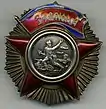 |
2nd Class 자유독립훈장 제2급 Sayu Tongnip Hunjang Che i-gŭp | ||
1st Class 군사복무영예훈장 제1급 Kunsa Pongmu Yŏng'ye Hunjang Che il-gŭp |
1973-07-03 | ||
2nd Class 군사복무영예훈장 제2급 Kunsa Pongmu Yŏng'ye Hunjang Che i-gŭp |
|||
3rd Class 군사복무영예훈장 제3급 Kunsa Pongmu Yŏng'ye Hunjang Che sam-gŭp | |||
1st Class 석탄광업복무영예훈장 제1급 Sŏkt'an Kwang'ŏp Pongmu Yŏng'ye Hunjang Che il-gŭp |
1973-09-03 | ||
2nd Class 석탄광업복무영예훈장 제2급 Sŏkt'an Kwang'ŏp Pongmu Yŏng'ye Hunjang Che i-gŭp |
|||
3rd Class 석탄광업복무영예훈장 제3급 Sŏkt'an Kwang'ŏp Pongmu Yŏng'ye Hunjang Che sam-gŭp |
|||
10 Years 군수공복무영예훈장 10 Kunsugong Pongmu Yŏng'ye Hunjang sip |
|||
20 Years 군수공복무영예훈장 20 Kunsugong Pongmu Yŏng'ye Hunjang isip |
|||
30 Years 군수공복무영예훈장 30 Kunsugong Pongmu Yŏng'ye Hunjang samsip |
|||
1st Class 수산복무영예훈장 제1급 Susan Pongmu Yŏng'ye Hunjang Che il-gŭp |
|||
2nd Class 수산복무영예훈장 제2급 Susan Pongmu Yŏng'ye Hunjang Che i-gŭp |
|||
1st Class 철도복무영예훈장 제1급 Ch'ŏldo Pongmu Yŏng'ye Hunjang Che il-gŭp |
|||
2nd Class 철도복무영예훈장 제2급 Ch'ŏldo Pongmu Yŏng'ye Hunjang Che i-gŭp |
|||
3rd Class 철도복무영예훈장 제3급 Ch'ŏldo Pongmu Yŏng'ye Hunjang Che sam-gŭp |
|||
1st Class 조선민주주의인민공화국친선훈장 제1급 Chosŏn Minjujuŭi Inmin Konghwaguk Ch'insŏn Hunjang Che il-gŭp |
1985 | Awarded only to non-nationals. Including;
Antonio Inoki | |
2nd Class 조선민주주의인민공화국친선훈장 제2급 Chosŏn Minjujuŭi Inmin Konghwaguk Ch'insŏn Hunjang Che i-gŭp |
Awarded only to non-nationals. Including; Alejandro Cao de Benos Norbert Vollertsen Ellsworth Culver Liu Xiaoming | ||

|
3대혁명붉은기훈장 Sam Tae Hyŏngmyŏng Pulg'ŭngi Hunjang |
1986-11-20 |
Commemorative Orders
(English/Korean/Transliteration) |
|||
조선인민군창건기념훈장 Chosŏn Inmin'gun Ch'anggŏn Kinyŏm Hunjang |
1968-01-25 | ||
조선민주주의인민공화국창건20주년기념훈장 Chosŏn Minjujuŭi Inmin Konghwaguk Ch'anggŏn Isip Chunyŏn Ginyŏm Hunjang |
1968-05-24 | ||
조선민주주의인민공화국창건기념훈장 Chosŏn Minjujuŭi Inmin Konghwaguk Ch'anggŏn Kinyŏm Hunjang |
1978 | ||
조국해방전쟁승리40돐기념훈장 Choguk Haebang Chǒnjaeng Sŭngri Sasip-dol Kinyŏm Hunjang |
1993 | ||
3월5일기념훈장 Sam-wŏl O-il Kinyŏm Hunjang |
1986-03-03 | ||
농촌데제발표30돐년기념훈장 Nongch'onde Chebal P'yo Samsip-dolnyŏn Kinyŏm Hunjang |
1990 | ||
조선인민군창건60돐기념훈장 Chosŏn Inmin'gun Ch'anggŏn Yusip-dol Kinyŏm Hunjang |
1992 | ||
수도건설기념훈장 Sudo Kŏnsŏl Kinyŏm Hunjang |
1992 | ||
조선민주주의인민공화국창건50돐년기념훈장 Chosŏn Minjujuŭi Inmin Konghwaguk Ch'anggŏn Osip-dolnyŏn Kinyŏm Hunjang |
1998 | ||
조국해방전쟁승리60돐기념훈장 Choguk Haebang Chǒnjaeng Sŭngri Yusip-dol Kinyŏm Hunjang |
2013-04-24[6] |
Medals
(English/Korean/Transliteration) |
|||

|
군공메달 Kun'gong Medal |
1949-07-13 | Awarded to more than 500,000 Koreans and more than 400,000 Chinese during the Korean War.[7] |

|
공로메달 Kongro Medal |
1949-07-13 | Awarded for meritorious labour service. |
군사복무영예메달 Kunsa Pongmu Yŏng'ye Medal |
1973-07-03 | ||
농업공로메달 Nong'ŏp Kongro Medal |
1974-12-24 | ||
조선민주주의인민공화국친선메달 Chosŏn Minjujuŭi Inmin Konghwaguk Ch'insŏn Medal |
1985 | ||
| 1990 |
Commemorative Medals
(English/Korean/Transliteration) |
||||
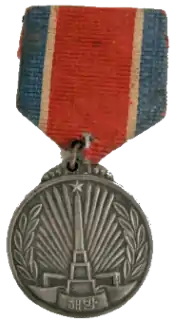 |
조선 1945.8.15 Chosŏn 1945.8.15 [8] |
1948-10-16[7] | Awarded for participation in the Korean independence armies. 10,000 awarded by 1949.[7] | |
위대한조국해방전쟁을기념메달 1950–1953 Widaehan Choguk Haebang Chǒnjaeng'ŭl Kinyŏm Medal 1950–1953 |
1953-08-15 | Awarded to all active and reserve enlisted personnel, non-commissioned officers, officers, generals and admirals of the KPA who participated in the Korean War of 1950–53. | ||
조국해방전쟁참전기념메달 1950–1953 Choguk Haebang Chǒnjaeng Ch'amjŏn Kinyŏm Medal 1950–1953 |
1953-08-15 | Awarded to all active and reserve enlisted personnel, non-commissioned officers, officers, generals and admirals of the KPA who participated in the Korean War of 1950–53. | ||
조국해방기념메달 Choguk Haebang Kinyŏm Medal |
Awarded to all active and reserve enlisted personnel, non-commissioned officers, officers, generals and admirals of the KPA who participated in the Korean War of 1950–53. | |||
조선민주주의인민공화국창건기념메달 Chosŏn Inmin'gun Ch'anggŏn Kinyŏm Medal |
||||
20총련기념메달 Isip Ch'ŏngryŏn Ch'anggŏn Kinyŏm Medal |
1975-05-20 | |||
정강산발전소건설기념메달 Chŏnggang Sanbaljŏnso Kŏnsŏl Kinyŏm Medal |
1990 | |||
수도건설기념메달 Sudo Kŏnsŏl Kinyŏm Medal |
1992 | |||
평양-남포고속도로건설기념메달 P'yŏngyang-Namp'o Kosoktoro Kŏnsŏl Kinyŏm Medal |
||||
열병식기념메달 Yŏlbyŏngsik Kinyŏm Medal |
Awarded to military units taking part in the various military parades in commemoration of state holidays. | |||
희천발전소건설기념메달 Huichŏn Paljŏnso Kŏnsŏl Kinyŏm Medal |
2011-10-23 | |||
| 2016 |
Badges
(English/Korean/Transliteration) |
|||
조선인민군창건20주년기념휘장 Chosŏn Minjujuŭi Inmin Konghwaguk Ch'anggŏn Isip Chunyŏn Kinyŏm Hwijang |
1968-02-08 | ||
천리마 영예 휘장 Ch'ŏllima Yŏng'ye Hwijang |
1968 |
Prizes
- Kim Il-sung Prize[9]
- Kim Il-sung Children Honor Prize[10]
- Kim Il-sung Youth Honor Prize[11]
- International Kim Il-sung Prize[12]
- People's Prize[13]
- February 16 Science and Technology Prize[14]
Honorary titles
Honorary titles include:
See also
References
Citations
- Yonhap News Agency (27 December 2002). North Korea Handbook. Seoul: M.E. Sharpe. p. 132. ISBN 978-0-7656-3523-5.
- Dong-Sam Sin (2016) Die Planung des Wiederaufbaus der Städte Hamhung und Hungnam in Nordkorea durch die DAG-Städtebaubrigade der DDR von 1955 - 1962. A dissertation for HafenCity Universität Hamburg
- "Democratic People's Republic of Korea_Juche Korea". korea-dpr.com. Retrieved 17 January 2014.
- "Past news". kcna.co.jp. Archived from the original on 12 October 2014. Retrieved 17 January 2014.
- "Ellsworth Culver honored by North Korea for life's work | Mercy Corps". mercycorps.org. Archived from the original on 21 February 2012. Retrieved 17 January 2014.
- "The 60th Anniversary of the Victorious Fatherland Liberation War Order and Its Miniature Decoration". Korea Today. Vol. 685 no. 7. 2013. ISSN 0454-4072.
- Weiser, Martin (8 January 2016). "Chests Full of Brass: A DPRK Political History in Orders, Medals, Prizes, and Titles". Sino-NK. Retrieved 16 April 2016.
- ru:Медаль «За освобождение Кореи»
- Michael Breen (1 February 2012). Kim Jong-Il, Revised and Updated: Kim Jong-il: North Koreas Dear Leader, Revised and Updated Edition. John Wiley & Sons. p. 43. ISBN 978-1-118-15377-2. Retrieved 4 July 2015.
- Kim Da Seul (22 June 2012). "Kim Il Sung's Image on Medals Changed". dailynk.com. Retrieved 8 October 2015.
- "Asian Football Business Review: North Korea's winning U-20 women receive awards". asianfootballbusiness.com. Retrieved 2015-08-27.
- James Hoare (13 July 2012). Historical Dictionary of Democratic People's Republic of Korea. Scarecrow Press. p. 181. ISBN 978-0-8108-6151-0. Retrieved 4 July 2015.
- Sin Sik Chai; Jong Hun Hyon (1980). Cultural policy in the Democratic People's Republic of Korea. Unesco. p. 37. ISBN 978-92-3-101645-5. Retrieved 4 July 2015.
- Rim, Sang Jun (2019). "Distinguished PhD in Materials Science". Korea Today. Vol. 759 no. 9. p. 20. ISSN 0454-4072.
- Valérie Gelézeau; Koen De Ceuster; Alain Delissen (2 May 2013). De-Bordering Korea: Tangible and Intangible Legacies of the Sunshine Policy. Routledge. p. 160. ISBN 978-1-136-19253-1. Retrieved 4 July 2015.
- History of Revolutionary Activities of Chairman Kim Jong Il. Pyongyang: Foreign Languages Publishing House. 2015. p. 327. ISBN 978-9946-0-1309-1.
- Min Yong Hwa. "Introduction". pulbora.edu.kp. Retrieved 11 February 2019.
- "Moranbong Middle School No. 1". naenara.com.kp. 11 February 2016. Retrieved 2016-02-11.
Sources
- Boik, William A. (2008). Orders, Decorations, and Medals of the Democratic People's Republic of Korea. Springfield, VA: DBMPress.com. ISBN 978-0-615-19087-7.
Further reading
- Cabral, David L. (1994). Orders and Decorations of the Democratic People's Republic of Korea. Glassboro, N.J.: Orders and Medals Society of America. OCLC 35914051.
- Lankov, Andrei (2014). "Honoring the Order of Medals". North of the DMZ: Essays on Daily Life in North Korea. Jefferson: McFarland. ISBN 978-0-7864-5141-8.
- Sainty, Guy Stair; Heydel-Mankoo, Rafal, eds. (2006). "Korea, Democratic People's Republic of (North)". World Orders of Knighthood and Merit. 2. Wilmington: Burke's Peerage & Gentry. ISBN 978-0-9711966-7-4.
- Sessler, Warren E.; McDaniel, Paul (2009). Military and Civil Awards of the Democratic People's Republic of Korea (DPRK). Henderson, Nevada: Sessler Incorporated. ISBN 978-0-615-28482-8.
- Werlich, Robert (1990). "Korea". Orders and Decorations of All Nations: Ancient and Modern, Civil and Military (2nd ed.). Washington: Quaker Press. OCLC 55357779.
External links
| Wikimedia Commons has media related to Orders, decorations and medals of North Korea. |
